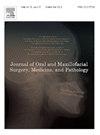A case of tongue granuloma requiring differentiation of Langerhans cell histiocytosis and Erdheim–Chester disease
IF 0.4
Q4 DENTISTRY, ORAL SURGERY & MEDICINE
Journal of Oral and Maxillofacial Surgery Medicine and Pathology
Pub Date : 2024-08-22
DOI:10.1016/j.ajoms.2024.08.008
引用次数: 0
Abstract
Granulomatous lesions in the head and neck include Langerhans cell histiocytosis (LCH) and Erdheim–Chester disease (ECD). ECD is a rare non-LCH characterised by histiocytic infiltration of multiple organ systems. In the head and neck region, there are some reports of its occurrence in the bony skeleton; however, it is extremely rare in soft tissues. Herein, we report a case of tongue granuloma requiring the differentiation of LCH and ECD. A 64-year-old man was referred to our hospital for swelling of the tongue and oral floor. We performed a biopsy and diagnosed ECD pathologically. However, as no bone lesions were identified in other parts of the body, a diagnosis of tongue granuloma was made. Following systemic administration of corticosteroids, the swelling of the tongue and oral floor completely disappeared. Steroids were gradually decreased, and there were no signs of recurrence of the disease. This case underscores the importance of considering ECD in the differential diagnosis of granulomatous lesions in the head and neck, even in soft tissues, and highlights the efficacy of corticosteroid therapy in managing associated symptoms.
舌肉芽肿需鉴别朗格汉斯细胞组织细胞增多症与厄德海姆-切斯特病1例
头颈部肉芽肿性病变包括朗格汉斯细胞组织细胞增多症(LCH)和埃尔德海姆-切斯特病(ECD)。ECD是一种罕见的非lch,以组织细胞浸润多器官系统为特征。在头颈部,有一些报道称其发生在骨骼中;然而,在软组织中极为罕见。在此,我们报告一例舌肉芽肿需要区分LCH和ECD。一名64岁男子因舌部及口腔底部肿胀转介至我院。我们进行了活检并病理诊断为ECD。然而,由于在身体其他部位未发现骨病变,因此诊断为舌肉芽肿。全身使用皮质类固醇后,舌部及口底肿胀完全消失。类固醇逐渐减少,没有疾病复发的迹象。本病例强调了在头颈部甚至软组织肉芽肿病变鉴别诊断中考虑ECD的重要性,并强调了皮质类固醇治疗在控制相关症状方面的疗效。
本文章由计算机程序翻译,如有差异,请以英文原文为准。
求助全文
约1分钟内获得全文
求助全文
来源期刊

Journal of Oral and Maxillofacial Surgery Medicine and Pathology
DENTISTRY, ORAL SURGERY & MEDICINE-
CiteScore
0.80
自引率
0.00%
发文量
129
审稿时长
83 days
 求助内容:
求助内容: 应助结果提醒方式:
应助结果提醒方式:


